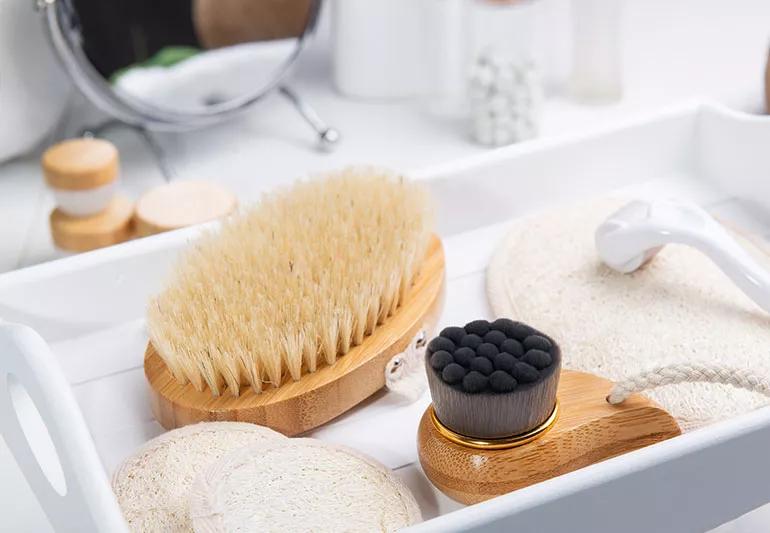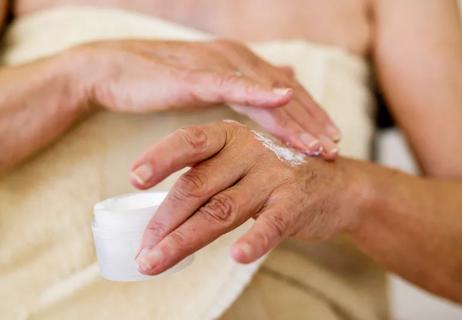Get tips for doing it correctly from a dermatologist

If you’re wondering about the best way to exfoliate and rejuvenate your skin, dry brushing is an option that offers many benefits. But before you grab a brush and start going to town on your skin, it’s important to know how to do it correctly and which areas should be avoided during the process.
Advertisement
Cleveland Clinic is a non-profit academic medical center. Advertising on our site helps support our mission. We do not endorse non-Cleveland Clinic products or services. Policy
If you’re not sure what dry brushing your skin is, it’s a daily body massage with a dry, stiff-bristled brush that’s said to help get rid of flaky skin, increase circulation, detoxify, help digestion – and even improve the appearance of cellulite.
But are these claims true?
“Some are true, but definitely not all,” says dermatologist Shilpi Khetarpal, MD. Keep reading to discover some helpful dry brushing tips and watch-outs for working on sensitive skin.
Dry brushing has gained traction for a reason. The list of benefits include:
The mechanical action of dry brushing is excellent for exfoliating rough, dry skin, she says. “Dry brushing unclogs pores in the exfoliation process. It also helps detoxify your skin by increasing blood circulation and promoting lymph flow/drainage,” says Dr. Khetarpal. Also, by unclogging pores, it’s easier for the body to sweat and eliminate toxins in your system.
Dry brushing can make you feel good since it has the additional benefit of stimulating your nervous system. It can also leave you feeling invigorated like a massage often does.
Removing dead skin cells can help make your skin smoother and softer. It can also give your skin a brighter appearance temporarily.
Advertisement
Hot water inflames your skin and even strips away oils, fats, and proteins that keep your skin healthy. This can cause redness and itching. Brushing your skin while it is dry allows you to exfoliate and increase blood circulation without robbing it of moisture the way the hot water in your shower can.
To get the benefits of dry brushing you’ll want to use a natural stiff-bristled bath or shower brush, preferably one with a long handle. Some bristles are stiffer than others, and it depends on your skin’s sensitivity and preference. The long handle is helpful for tough-to-reach areas like your back.
It’s possible to use a dry brush if you have sensitive skin. For dry brushing to be fully effective, the bristles must generally be pretty firm. But if your skin is too sensitive, you can use a plain, dry washcloth. If you notice redness, swelling or inflammation while brushing, stop right away.
Also, never dry brush over moles, warts, or raised bumps among many other things. See your dermatologist if you have questions.
“Do not use dry brush or cloth on skin that’s broken. This includes cuts, scrapes, lesions, sores or burned skin, including sunburns,” she adds. “Don’t ever brush over areas of infection, redness or general irritation, inflammation, cellulitis or skin cancer. Stop dry brushing if skin becomes irritated or inflamed.”
Dr. Khetarpal also points out to avoid using a dry brush on your face since the skin is more sensitive than on the rest of your body. “If you want to exfoliate your face, use more gentle products and methods that are designed for specifically for it,” she says.
The best time to dry brush is just before a shower. Then you can wash off any dead skin cells and flaky skin. Be sure to apply lotion afterward to put moisture back into your skin.
If you’re new to dry brushing or not sure if you’ve been doing it correctly, Dr. Khetarpal offers these tips:
There is no proof dry brushing your skin reduces cellulite or the appearance of cellulite — this claim isn’t supported by any scientific evidence.
Advertisement
“It’s likely that what people interpret as cellulite reduction is really just a temporary plumping up of the skin from increased blood circulation,” Dr. Khetarpal says.
“Remember, make sure you begin the process by getting to know your skin first and giving it a look to see if there are any areas to avoid,” she emphasizes. “If you notice any concerning changes in your skin make an appointment with your dermatologist, especially before you begin any change in your skincare routine.”
Advertisement
Learn more about our editorial process.
Advertisement

Deal with dry skin by preserving your skin’s moisture, using moisturizing products and taking preventive action

Choose cream for your body and lotion for your face, and skip the fragrances and botanicals

Several conditions, like vitiligo and fungal infection, can cause a loss of pigmentation, leading to white spots or patches on your skin

Moisturizing, running a humidifier and adjusting your showers may help keep itchiness and irritation at bay

‘Zit stickers’ can help heal a new or popped pimple, but they’re limited when it comes to managing acne

Glycolic acid benefits skin tone, texture and pigmentation by exfoliating dead skin

At-home treatments and lifestyle changes may help ease the symptoms and improve the appearance of varicose veins — but they aren’t a cure

Scalp cancers can occur because of long-term sun exposure

The ‘sunshine vitamin’ is found naturally in some fish and is added to other foods

Autism and ADHD often go hand in hand, giving rise to the term AuDHD

The Yuzpe regimen is less effective than other forms of emergency contraceptives, and it’s associated with more side effects